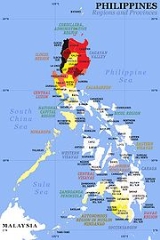
Ilokano language
Overview
Ilokano or Ilocano is the third most-spoken language
of the Republic of the Philippines
.
An Austronesian language
, it is related to such languages as Indonesian
, Malay
, Fijian
, Maori
, Hawaiian
, Malagasy
, Samoan
, Tahitian
, Chamorro
, Tetum, and Paiwan
.
The Ilocano people
are an Austronesian
-speaking people. Families and clans arrived by viray or bilog, or "boat". The term Ilocano, as commonly accepted, originates from i-, which denotes "from", and looc, meaning "cove or bay", thus giving them the name "People of the bay." Some modern scholars, however, argue that as far as the Ilocano tradition of giving names to their place of residency is concerned, the i + looc etymology is actually an exonym.
Languages of the Philippines
In the Philippines, there are between 120 and 175 languages, depending on the method of classification. Four languages no longer have any known speakers. Almost all the Philippine languages belong to the Austronesian language family...
of the Republic of the Philippines
Philippines
The Philippines , officially known as the Republic of the Philippines , is a country in Southeast Asia in the western Pacific Ocean. To its north across the Luzon Strait lies Taiwan. West across the South China Sea sits Vietnam...
.
An Austronesian language
Austronesian languages
The Austronesian languages are a language family widely dispersed throughout the islands of Southeast Asia and the Pacific, with a few members spoken on continental Asia that are spoken by about 386 million people. It is on par with Indo-European, Niger-Congo, Afroasiatic and Uralic as one of the...
, it is related to such languages as Indonesian
Indonesian language
Indonesian is the official language of Indonesia. Indonesian is a normative form of the Riau Islands dialect of Malay, an Austronesian language which has been used as a lingua franca in the Indonesian archipelago for centuries....
, Malay
Malay language
Malay is a major language of the Austronesian family. It is the official language of Malaysia , Indonesia , Brunei and Singapore...
, Fijian
Fijian language
Fijian is an Austronesian language of the Malayo-Polynesian family spoken in Fiji. It has 450,000 first-language speakers, which is less than half the population of Fiji, but another 200,000 speak it as a second language...
, Maori
Maori language
Māori or te reo Māori , commonly te reo , is the language of the indigenous population of New Zealand, the Māori. It has the status of an official language in New Zealand...
, Hawaiian
Hawaiian language
The Hawaiian language is a Polynesian language that takes its name from Hawaii, the largest island in the tropical North Pacific archipelago where it developed. Hawaiian, along with English, is an official language of the state of Hawaii...
, Malagasy
Malagasy language
Malagasy is the national language of Madagascar, a member of the Austronesian family of languages. Most people in Madagascar speak it as a first language as do some people of Malagasy descent elsewhere.-History:...
, Samoan
Samoan language
Samoan Samoan Samoan (Gagana Sāmoa, is the language of the Samoan Islands, comprising the independent country of Samoa and the United States territory of American Samoa. It is an official language—alongside English—in both jurisdictions. Samoan, a Polynesian language, is the first language for most...
, Tahitian
Tahitian language
Tahitian is an indigenous language spoken mainly in the Society Islands in French Polynesia. It is an Eastern Polynesian language closely related to the other indigenous languages spoken in French Polynesia: Marquesan, Tuamotuan, Mangarevan, and Austral Islands languages...
, Chamorro
Chamorro language
Chamorro is a Malayo-Polynesian language, spoken on the Mariana Islands by about 47,000 people Chamorro (Chamorro: Fino' Chamoru or simply Chamoru) is a Malayo-Polynesian (Austronesian) language, spoken on the Mariana Islands (Guam, Rota, Tinian, and Saipan) by about 47,000 people Chamorro...
, Tetum, and Paiwan
Paiwan language
Paiwan is a native language of Taiwan, spoken by the Paiwan people, one tribe of the Taiwanese aborigines. Paiwan is a Formosan language of the Austronesian language family...
.
The Ilocano people
Ilocano people
The Ilocano or Ilokano people are the third largest Filipino ethnolinguistic group. Aside from being referred to as Ilocanos, from "i"-from, and "looc"-bay, they also refer to themselves as Samtoy, from the Ilocano phrase "sao mi ditoy", meaning 'our language here.' The word "Ilocano" came from...
are an Austronesian
Austronesian languages
The Austronesian languages are a language family widely dispersed throughout the islands of Southeast Asia and the Pacific, with a few members spoken on continental Asia that are spoken by about 386 million people. It is on par with Indo-European, Niger-Congo, Afroasiatic and Uralic as one of the...
-speaking people. Families and clans arrived by viray or bilog, or "boat". The term Ilocano, as commonly accepted, originates from i-, which denotes "from", and looc, meaning "cove or bay", thus giving them the name "People of the bay." Some modern scholars, however, argue that as far as the Ilocano tradition of giving names to their place of residency is concerned, the i + looc etymology is actually an exonym.
Unanswered Questions

